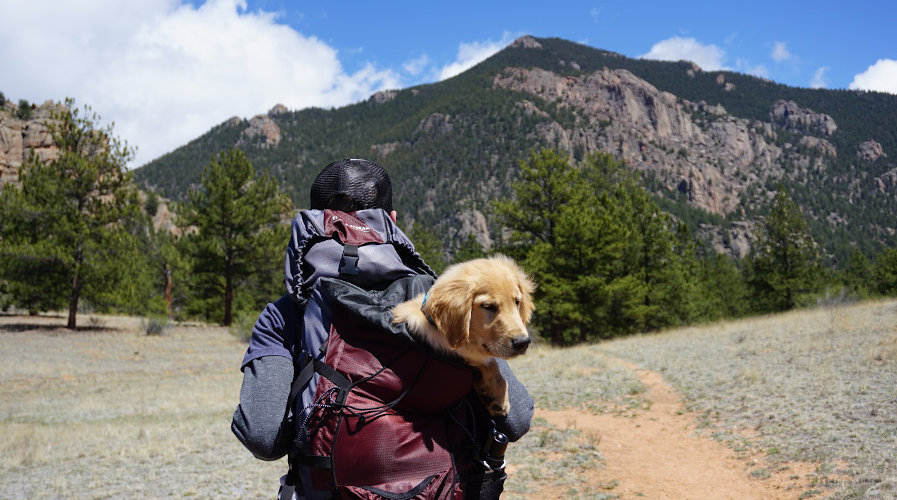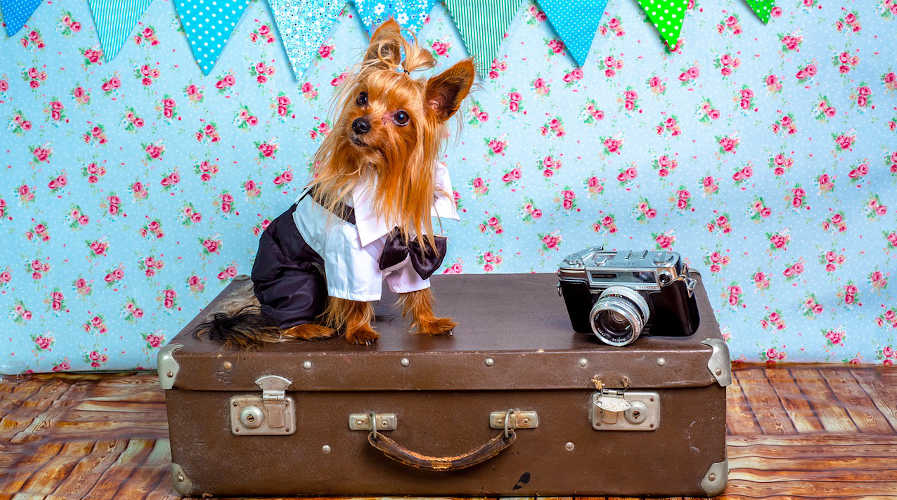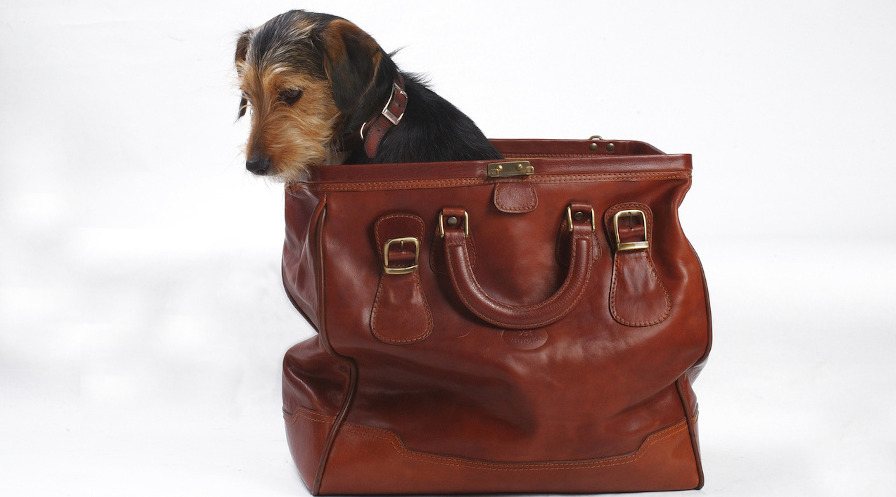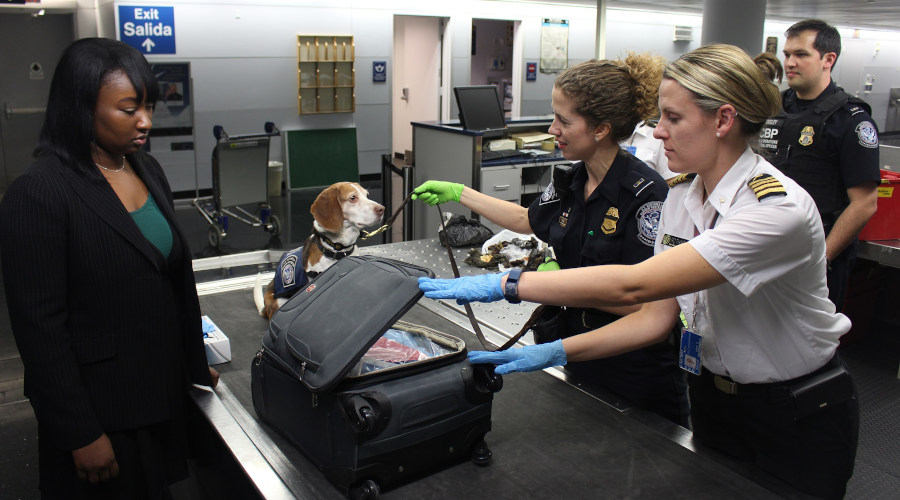So you’ve decided to do some international travel with dogs, but you’ve got a ton of questions like:
- What airlines allow pet travel?
- Which airline is the most pet friendly?
- How much does it cost to travel with a pet?
- How stressful is flying for dogs?
In this comprehensive article, we will break down the do’s and don’ts to international pet travel and give you a full resource of what you will need to do before, during and after your flight.
There are usually three ways to ship your pet internationally: In the cabin, as cargo or via a licensed commercial shipper.
The Cabin
You can take your pet on board with you in-cabin. This is perfect for shorter flights but only applies to certain types of smaller dogs that can fit on the plane in a designated area.
As Cargo
You can book your pet in as cargo (sometimes on the same flight and sometimes on another flight) This is more expensive but enables you to travel internationally. There are restrictions on which pets can fly and some airlines no longer offer this option.
Commercial Shipper
You can hire a licensed commercial shipper to ship your pet for you. This is becoming more popular but you will be charged the cargo rate plus an additional shipper’s fee. More airlines recommend this method unless your pet is small enough to fit in the cabin.
In this article, we will focus on international pet travel via cargo. You can get more commercial shipper information here.
A Comprehensive Guide to International Travel With Dogs
International pet travel can be difficult to manage as different airlines have very different policies. That’s especially true during this time when airlines are updating their policies due to COVID-19.
On top of that, there are mandatory veterinarian checks that must happen before travel, and sometimes there are border control obstacles that you will encounter once you reach your destination.

Traveling with your pet is a wonderful adventure, but make sure to do your research before bringing them abroad.
Overall international pet travel can prove to be a logistical nightmare, but rest assured we’ll try to give you the best advice for a more stress-free experience.
Many owners decide to get their pet microchipped before they travel, just in case they get lost. It is now a mandatory requirement to get your pet tagged before you fly and there are also other health certificates that you must obtain from a veterinarian before you travel.
Remember, when it comes to international pet travel you should also try to stay informed. Make sure you check your airline’s requirements weeks before you are due to fly. In that way, you won’t be surprised by additional recommendations, rules or obligations when it’s too late.
Also, remember that in this article we are primarily talking about pets. If you want to travel with an emotional support animal or a service animal, airlines may have special accommodations that you can take advantage of.
What If You’re Flying With a Cat?
Much of what we say in this article also applies to cats. But as cats and dogs are indeed different, cats may require special considerations. Flying in the cargo can be stressful for your cat due to abnormal temperatures and air pressures. Additionally, many felines get lost or injured during transit as cargo.
Flying with your cat when it’s either too hot or too cold is also not recommended. Instead try to go with an airline that allows you to travel with your cat on board, usually for an additional fee.
Always remember to call the airline in advance to reserve a spot. Only a limited number of animals are usually allowed in the cabin on each flight so to avoid disappointment, book them onboard as early as possible.
Thinking of Traveling to Mexico?
Read our article: Pros And Cons Of Doing Business In Mexico — Should You Go?
International Flights Guidance
If you plan on flying internationally, you will need to obtain an international health certificate.
This will show that your pet is healthy and has all the necessary documents to fly legally. You will also need it to be allowed into your destination country. Visit the U.S. Department of Agriculture’s Animal and Plant Health Inspection Service website to learn more.

Make sure to obtain an international health certificate for your dog to ensure that he or she is healthy.
Once you return to the US you will need proof of immunization against rabies, according to the Centers for Disease Control and Prevention.
Some airlines recommend that you get into contact with the correct embassy at least 4 weeks before your departure to ensure you can conform to the country’s entry requirements.
How much does international pet travel cost?
Gone are the days when your pet could travel for free (besides service animals, they always travel for free). Some airlines will charge a smaller fee for pets that travel in the cabin. However, for international travel, you will have no other choice but to fly with your dog as cargo which will undoubtedly be more expensive.
The majority of the bigger airlines charge $125 for in-cabin one-way tickets. However, pets that fly as cargo will usually incur a higher charge. A good example of this is American Airlines which charges $200 for a single trip ($400 round trip).
If you are flying internationally, then things can start to get very expensive with delays, flights, layovers, and other storage costs.
Learn More
Want to travel to a tropical island? Read our article: Why Paradise Is The Perfect Place To Invest Your Money
How Do I Check My Pet in as Cargo?
For bigger dogs and long haul or international flights, checking in your pet as cargo is the preferred option. Your pet will be checked in, in a similar process to cargo, and fly in a secluded part of the belly of the plane. Different airlines will have their own policies on how and when you can book your pet as cargo, for example, Delta will not let you book a pet until 14 days before departure.
However, it’s important to know that not all airline companies will transport dogs as cargo. Southwest Airlines, for example, offers only in-cabin flights for pets and therefore caters to only small dogs and cats.

Make sure to read up on the airline you are flying with to determine their pet rules and regulations.
Alternatively, some airlines won’t allow pets to fly internationally at all, so you must book with the right airline to avoid any problems. (Don’t worry we’ll go over the most friendly pet airlines later.)
It’s perfectly safe to travel with pets in the cargo area of the plane. With extremely low in-flight injuries, your pet should be safe and sound and ready to smother you with affection when they land.
Important note:
Some airlines have stringent rules for the weight and age of your dog. For example, United Airlines requires dogs to weigh at least 2 pounds or can fly only when they are at least 10 weeks old.
Pet Health and Travel
Before you fly, you must check with your local veterinarian to make sure that your pet is healthy enough to fly. As you are planning an international trip and not a domestic one, this is even more significant as you may need to get additional shots or checks for whichever part of the world you are traveling to.
Most countries require your pet to be implanted with a 15 digit non-encrypted microchip. You will also need to get a vaccination against rabies if you live in an area of the country that is rabies-controlled. This must take place at least 30 days before you travel.
Remember, even if your pets have been vaccinated before, they will have to get vaccinated again if they have not been microchipped. It’s important to consider that some regions of the world also require more vaccinations and additional red tape, so always check with your airline before you fly.
For example, if you are traveling to Europe, on top of getting your pet microchipped and getting the rabies vaccination, you will need vaccinating for distemper.
Traveling Abroad for Business?
Here are the top tips for international business from some business leaders in the US Southeast.
Also, some airlines do not allow particular breeds of dogs to fly. These are breeds that have a predisposition to breathing difficulties at high altitudes. Examples include pug-nosed dogs such as boxers and Boston terriers.
You may also need additional health certificates depending on which airline you fly with, so be sure to check the rules, restrictions, and guidelines before you travel.
Do I need a veterinary health certificate?
All countries require a veterinary health certificate. This needs to be done before you fly and each certificate will be slightly different depending on where you are flying to. After obtaining one you will need to have your veterinarian fill it out within 10 days of departure.
If traveling from the U.S. or Canada, the certificate must be endorsed by a USDA or CFIA accredited veterinarian.
If you need to get more information on which part of the world requires which documents, then view your destination country’s embassy to get the correct paperwork.
What about Quarantine?
Some parts of the world have very strict policies on quarantine, so you must check your destination country before travel. The good news is if you have the necessary paperwork and have had all the vaccinations and microchips installed, you can usually bypass this requirement.

Be aware of animal quarantine regulations in the country you are traveling to. A disease borne by animal travelers can have a devastating effect on a country’s agriculture industry.
Dog Crates: What Do I Need To Know?
Most airlines have very detailed and strict requirements for the box (or dog crate) your dog travels in. They usually need to be big enough for your dog to stand up, stretch, and turn around it.
Here are a few tips to take into consideration when picking out a dog crate:
- Include a label on your dog’s crate with your contact info.
- Write the words “LIVE ANIMAL” on the top and at least one side of the dog crate.
- Make sure you put enough bedding and material that is very “absorbent” on the floor.
Departure Guidelines
When planning your departure, there are a few tips that we would recommend. Use these for a more stress-free flying experience:
Try to book a nonstop flight. This is a safer option and will decrease stress levels for your pet.
If you have a layover, ensure you have taped food outside the dog crate for airline workers to feed your dog. This is recommended by ASPCA.
Avoid flying during holidays and weekends when it is busier.

Check with the airline you are flying with to determine what kind of pet carrier you need for bringing your dog.
Alternatively, we would recommend doing a few additional things to prepare your pet before they fly. Besides showering them with affection, take these things into consideration:
- Do NOT sedate your pet. It may be against the terms of travel.
- Freeze some water in a dish the day before you fly. This will prevent it from spilling during transit and loading. Once your dog is in the air, it will have melted, so they can drink it.
- Put an up-to-date photo on top of the dog crate just in case your dog tries to escape.
- Keep your dog’s stomach on the empty side before travel as a full stomach can cause discomfort.
On the Day of Travel
On the day of travel, make sure you get to the airport early and go to the correct counter to check-in pets. This may be different from the passenger terminal, so be prepared to either ask a member of staff for the cargo terminal or do some research before you get there so you know exactly where to do.
Small things like this will make your flying experience more problem-free.

When flying with your dog, arrive to the airport extra early to avoid any issues.
Airline pet policies
Details of pet policies vary widely by each airline, so it’s best to check directly with the carrier when you’re planning a trip. Here are links to pet policies of large U.S. airlines:
- Alaska Airlines
- American Airlines
- Delta Air Lines
- Hawaiian Airlines
- JetBlue Airways
- Southwest Airlines
- United Airlines
Overall, international pet travel shouldn’t be a stressful experience. Make sure you do your research before you fly and try to plan well ahead of time just in case things change. Using the tips above, you can make things much easier and worry-free!
Frequently Asked Questions
Which Airline Is the Most Pet Friendly?
American Airlines
Pets are allowed in the cabin for short flights, but for long-haul flights pets have to be checked as cargo. Fees will vary from flight to flight, and the size of your pet does make a difference. Price: $125 – $200
Delta Airlines
Boasting the most destinations with up to 60 countries across the globe, Delta welcomes long haul international flights. Prices range from $75 to $200. (They even welcome household birds if you are flying domestically!)
JetBlue
It could be one of the more pet-friendly airlines as they offer a pet loyalty program! It’s $100 domestic, more for international.
How Much Does International Travel With Dogs Cost?
Most of the major airlines that do allow pets to fly will usually allow one pet per passenger. The average cost each way across the majority of airlines is $125.00 each way for domestic flights. International flights vary so you should seek exact prices from your airline before travel.
How Stressful Is Flying for Dogs?
Flying can be stressful for dogs. Many veterinarians agree that sedating a pet for travel is not the best way to go as the risks outweigh the benefits. Sedation increases the risk of breathing issues, which can cause death. This is why sedation is no longer considered a safe option for pet travel.
Amy Davis: Hey, I’m Amy and I’m in love with Pets! I have a diverse variety, including 2 cats, 1 dog, 3 rabbits, 2 guinea pigs, a rat, and a beautiful macaw. I love writing about everything pet-related and spend as much time as I can sharing my personal experiences on my blog. UltimatePetHub.com
Have a story about traveling with your pets?
Leave a reply in the comments below to tell us about your experiences traveling with pets!




It’s wild how much it costs to bring your pet anywhere with you these days. Prior to COVID, I traveled often for work and would sometimes take my pooch with me, but the cost adds up after a while. One thing that I found helpful was how the website https://www.dogsonplanes.com breaks down all of the different airline policies. Definitely less stressful when you know what you’re getting into!
Nice to know!
That makes sense that airlines have certain cage requirements. I need to take my dog to Italy this summer. I’ll have to make sure I have plans in place to pick up his feces.
If you’re flying with your pet, it’s a great choice to ride in a private jet. There are lots of advantages if you choose to fly privately. You can bring more pets, there’s a large space and more attention can be given to them. Your pet can experience more comfort and it’s safer.